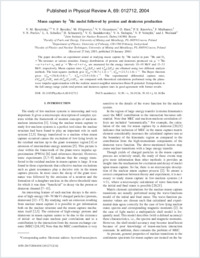Muon capture by ³He nuclei followed by proton and deuteron production
- Bystritsky, V. M. Joint Institute for Nuclear Research, Dubna, Russia
- Boreiko, V. F. Joint Institute for Nuclear Research, Dubna, Russia
- Filipowicz, M. Faculty of Fuels and Energy, University of Mining and Metallurgy, Cracow, Poland
- Gerasimov, V. V. Joint Institute for Nuclear Research, Dubna, Russia
- Huot, Olivier Department of Physics, University of Fribourg, Switzerland
- Knowles, Paul E. Department of Physics, University of Fribourg, Switzerland
- Mulhauser, Françoise Department of Physics, University of Fribourg, Switzerland
- Pavlov, V. N. Joint Institute for Nuclear Research, Dubna, Russia
- Schaller, Lukas A. Department of Physics, University of Fribourg, Switzerland
- Schneuwly, Hubert Department of Physics, University of Fribourg, Switzerland
- Sandukovsky, V. G. Joint Institute for Nuclear Research, Dubna, Russia
- Stolupin, V. A. Joint Institute for Nuclear Research, Dubna, Russia
- Volnykh, V. P. Joint Institute for Nuclear Research, Dubna, Russia
- Woźniak, J. Faculty of Physics and Nuclear Techniques, University of Mining and Metallurgy, Cracow, Poland
-
29.01.2004
Published in:
- Physical Review A. - 2004, vol. 69, p. 012712-12727
English
The paper describes an experiment aimed at studying muon capture by He nuclei in pure ³He and D₂+³He mixtures at various densities. Energy distributions of protons and deuterons produced via µ₋+³He-->p + n + n + νµ and µ₋+³He-->d + n + νµ are measured for the energy intervals 10–49 MeV and 13–31 MeV, respectively. Muon capture rates lambdacapp(ΔEp) and lambdacapd(ΔEd) are obtained using two different analysis methods. The least-squares methods give lambdacapp = (36.7±1.2) s–1, lambdacapd = (21.3±1.6) s–1. The Bayes theorem gives lambdacapp = (36.8±0.8) s–1, lambdacapd = (21.9±0.6) s–1. The experimental differential capture rates, dlambdacapp(Ep)/dEp and dlambdacapd(Ed)/dEd, are compared with theoretical calculations performed using the plane-wave impulse approximation with the realistic nearest-neighbor interaction Bonn B potential. Extrapolation to the full energy range yields total proton and deuteron capture rates in good agreement with former results
- Faculty
- Faculté des sciences et de médecine
- Department
- Département de Physique
- Language
-
- English
- Classification
- Physics
- License
-
License undefined
- Identifiers
-
- RERO DOC 4256
- DOI 10.1103/PhysRevA.69.012712
- Persistent URL
- https://folia.unifr.ch/unifr/documents/299822
Statistics
Document views: 129
File downloads:
- Texte intégral: 201
